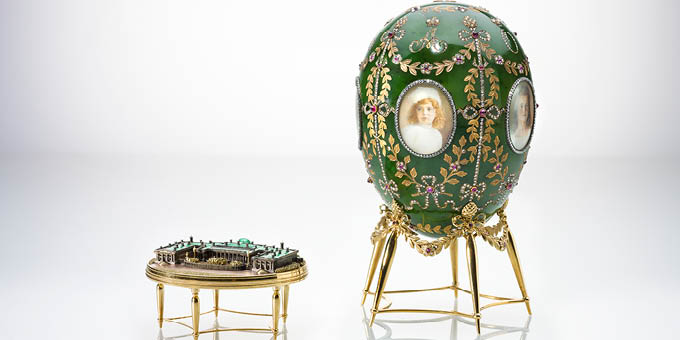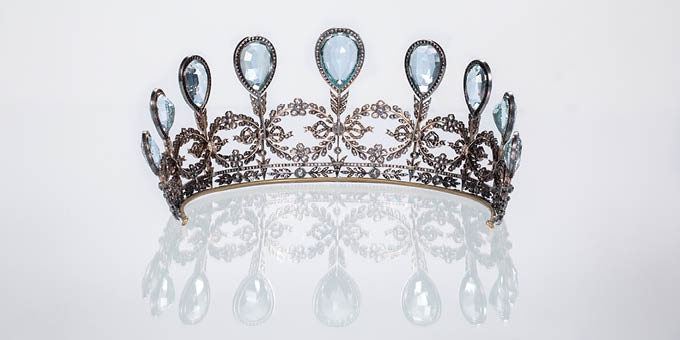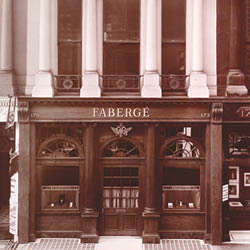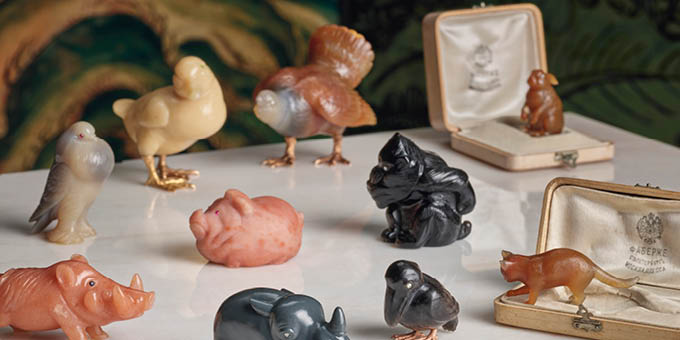
The works of Russian jeweller Carl Fabergé have been fascinating London museum crowds in a dedicated Fabergé exhibition, writes Oonagh Turner for The London Magazine
A byword for opulence, the name Fabergé is evocative of glistening diamonds, lost dynasties, the beauty, wealth and romance of late Imperial Russia and Edwardian high society, and those fabulous Easter eggs. The jeweller’s ingenious works have long sparked wonder and awe in collectors, history aficionados and art lovers, and his works are still making waves in the capital.
At the V&A, an exquisite collection of works by Peter Carl Fabergé (known as Carl) have been exhibited since November, amassed from private collectors, museums across the world, and British families whose Fabergé treasures have been passed down through the generations. Meanwhile, Christie’s hosted an auction made up of a selection of 86 Fabergé masterpieces from The Harry Woolf Collection at the end of last year – second only to the UK Royal Collection of Fabergé, this very rare collection contained objets d’art that range in value from £2,000 to £200,000.

“The first thing people think about are the Easter eggs,” says Kieran McCarthy, exhibition curator at the V&A. “But there are so many more layers to the Fabergé story.” It’s not just the beguiling objects themselves, but how each piece provides a portal to a bygone era and an astute insight into society during the early 20th century. People typically bought Fabergé’s works as gifts for others and so by chasing the provenance of these objects you get to use them as a peephole into the lives and works of these people – these are the props by which to understand the most private lives,” explains McCarthy. “Every lust, every ambition, every sort of social climbing manoeuvre, every friendship, anniversary and love are expressed in the exchange of these gifts.”
The story of Fabergé in London
The history of Fabergé also helps us understand the capital’s status on a world stage at the time. London was profoundly international. “It was a city of the world – you had Americans, Indians, French, Thais, you name it, London was the ultimate destination for the international elite, and turning into Moscow on Thames,” says McCarthy. And everyone wanted a slice of Fabergé’s craftmanship. “European monarchs, Indian maharajas, English aristocrats and American heiresses all aspired to acquire the latest creation from the Fabergé workshop,” says Christie’s London Russian Works of Art Specialist, Margo Oganesian. It was only fitting then that Fabergé set up shop in London in 1903, the only branch outside of Russia, from where he catered to his growing patrons.
In 1911, the branch moved to New Bond Street, just weeks after Sergei Diaghilev’s Ballets Russes opened its first season at Covent Garden. It was understated and didn’t need to advertise, its windows only displaying a brief curation of objects. The only way to know of its existence was through word of mouth. “It was almost this social secret and means of social advancement, you’d see the King and Queen come out of Fabergé’s, the Duchess of Devonshire,” says McCarthy.

As well as the Royals, Fabergé’s works were also being purchased by the growing expat Russian community. The aristocrats of Edwardian society wanted their own Fabergé, and like the businessman he was, the master craftsman began to tailor his creations towards this demographic – reflecting the lifestyles of the British elite he was serving. “Fabergé began producing studies of his customers’ prized racehorses and immortalising vistas of the British landscape in enamel. You’d see scenes of the Houses of Parliament or Shakespeare’s church in Stratford. Russia and London came together through Fabergé and this is what we explore,” explains McCarthy.
Fabergé exhibition highlights
One particular piece at the exhibition that McCarthy is thrilled to have at the V&A was owned by the Royal Family. “Edward VII was not the most monogamous of gentlemen, and his long-term mistress Alice Keppel gave the King the most beautiful and layered gold box, enamelled in royal blue which was entwined with a diamond set snake swallowing its own tail – the symbol of never-ending love.” The exhibition also showcases a host of extravagant tiaras. “One is modelled as aquamarine cupid arrows pointing towards the mind of the wearer – it’s an utterly magical object,” adds McCarthy.
For Oganesian, the famous Fabergé mosaic brooch was a highlight at the Christie’s auction. Designed by Alma Pihl – one of the two female designers at Fabergé, this incredibly delicate brooch features hand-carved minute diamonds, rubies, and emeralds. “The stones are fitted into the square holes of the platinum mesh, which was cut by hand. The same technique was used for the Imperial Mosaic Egg presented by Emperor Nicholas II to his wife Alexandra Feodorovna in 1914, which is now part of the Royal Collection. The ingenuity of the design makes it an irresistible artwork for any collector,” says Ogranesian.

By 1918, the Fabergé craze had come to an end. In London, the outbreak of the First World War meant the flow of materials from Russia dried up. In Russia, Fabergé’s pieces were seen as total anathema to the Bolsheviks’ ethos and Fabergé fled, eventually dying in Switzerland in 1920. “The name Fabergé died young and beautiful,” says McCarthy. But even today, Fabergé pieces remain as highly sought after as they were more than a century ago when first created. “The jeweller’s impeccable craftsmanship and wit remains unrivalled to this day,” comments Oganesian. “His ability to catch hold of an idea and represent it in a small piece of rare stone or precious metal earned the admiration of everyone who saw his creations, and this collection is one of the most iconic in private hands.”
It’s this glamorous, whimsical, romantic story about the beauty coming from this relationship between Britain and Russia that visitors can expect to glean from a trip to the exhibition, which runs until May 2022. “It’s joyful and it’s escapism,” says McCarthy. “People will float out of the exhibition on a cloud of gemstones.”
Fabergé: Romance to Revolution will be showing until 8 May 2022 at the V&A.





 © 2024
© 2024